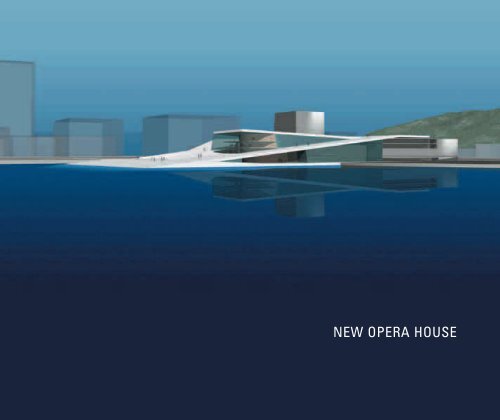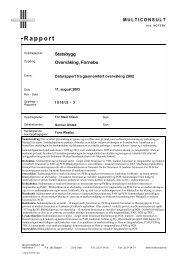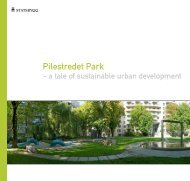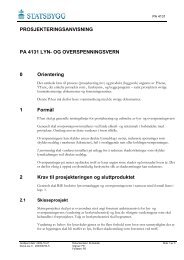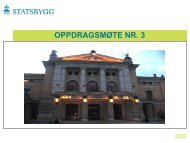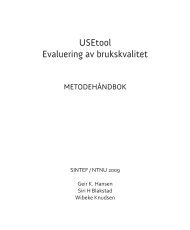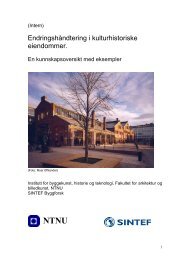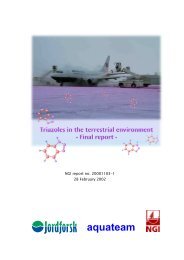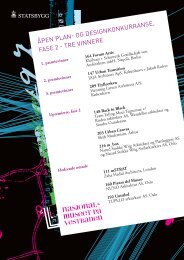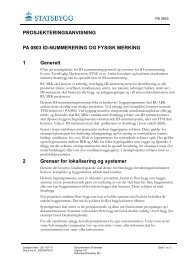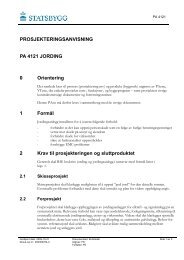Presentation of the project New Opera House - Statsbygg
Presentation of the project New Opera House - Statsbygg
Presentation of the project New Opera House - Statsbygg
Create successful ePaper yourself
Turn your PDF publications into a flip-book with our unique Google optimized e-Paper software.
NEW OPERA HOUSE
Foyer<br />
Main Auditorium<br />
Flytower with understage areas<br />
Production Area
The <strong>Opera</strong> Plaza towards <strong>the</strong> front entrance.<br />
KEY FIGURES, THE NEW OPERA HOUSE<br />
GROSS AREA 38.500 m 2<br />
PUBLIC AREA 11.200 m 2<br />
STAGE AREAS 8.300 m 2<br />
REHEARSAL ROOMS, ADMINISTRATION, WORKSHOPS 19.100 m 2<br />
BASE AREA 15.590 m 2<br />
LENGTH INCL. PLAZA 242 m<br />
LENGTH OF BUILDING 207 m<br />
WIDTH OF BUILDING 110 m<br />
SEATING CAPACITY IN THE MAIN AUDITORIUM 1.350<br />
SEATING CAPACITY SCENE 2 400<br />
MAXIMUM CEILING HEIGHT OVER STAGE 54 m<br />
DEPTH OF STAGE UNDER SEA LEVEL 16 m
THE OPERA HOUSE<br />
The construction <strong>of</strong> <strong>the</strong> new <strong>Opera</strong> <strong>House</strong> is <strong>the</strong> largest single culture-political initiative in contemporary Norway. The <strong>Opera</strong> <strong>House</strong>, which is <strong>the</strong> largest cultural<br />
building to be raised in Norway since Nidarosdomen, shall be an important symbol <strong>of</strong> what modern Norway represents as a nation, and express <strong>the</strong> role opera and<br />
ballet shall have in society.<br />
The base area <strong>of</strong> <strong>the</strong> <strong>Opera</strong> <strong>House</strong> is <strong>the</strong> same as <strong>the</strong> total area covered by four international standard football fields.<br />
The building has 1100 rooms grouped in a number <strong>of</strong> sections. These are:<br />
The public area lies in <strong>the</strong> west wing, with access from <strong>the</strong> area adjacent to Oslo Central Station.<br />
The public area encompasses <strong>the</strong> foyer, <strong>the</strong> Main auditorium with seating for up to 1350, Scene 2<br />
with seating for up to 400, and a rehearsal room that seats 200. The Main auditorium is a classic<br />
horseshoe shaped opera <strong>the</strong>atre with a high-level ceiling designed to strict acoustic requirements,<br />
affording excellent sight lines from all seats. The Main auditorium is capable <strong>of</strong> catering for <strong>the</strong><br />
whole range <strong>of</strong> classic and modern opera and<br />
ballet, as well as concerts and musicals. Scene<br />
2 will accommodate several more forms <strong>of</strong><br />
artistic expression, as well as opera and ballet<br />
repertoire more suitable for a smaller stage due<br />
The stage area The <strong>Opera</strong> <strong>House</strong> has one <strong>of</strong> <strong>the</strong> most modern and technologically<br />
advanced opera stages in <strong>the</strong> world. Covering a large surface area, in addition to<br />
<strong>the</strong> main stage, <strong>the</strong>re are side stages, back stages and an understage allowing<br />
nine metre high scenery sets to be prepared under <strong>the</strong> main stage and elevated<br />
to its form and format. The foyer area will be<br />
a large, open room with varied natural lighting<br />
and fine views <strong>of</strong> <strong>the</strong> fjord and Hovedøya. In<br />
during performances. Electric motors ensure that <strong>the</strong> stage turntable<br />
revolves noiselessly. The main stage has an area <strong>of</strong> 16x16 metres, which<br />
comprises <strong>of</strong> 16 individual elements that can be elevated, angled,<br />
Production section. This is<br />
where <strong>the</strong> workshops, stores,<br />
rehearsal rooms, cloakrooms, <strong>of</strong>fices<br />
addition to <strong>the</strong> intermission area, cloakrooms<br />
and toilets, <strong>the</strong> foyer also houses ticket sales, an<br />
information- and arrangements centre, coming<br />
or rotated so that landscapes can be constructed on <strong>the</strong> stage.<br />
The 35-metre high stage tower is located above <strong>the</strong> main stage,<br />
allowing for complicated <strong>the</strong>atre-technical solutions. Moveable<br />
and audition rooms are located, all<br />
facilities that are necessary for <strong>the</strong> production<br />
<strong>of</strong> an opera or ballet. The building<br />
attractions exhibits, an opera shop, restaurant,<br />
cafe and bars. The room will be designed with a<br />
limited number <strong>of</strong> materials and minimalist detail<br />
prosceniums on both sides <strong>of</strong> <strong>the</strong> main stage can<br />
reduce or increase <strong>the</strong> stage front opening for best possible<br />
adaptation and utilisation <strong>of</strong> acoustics and stage area.<br />
has four floors plus a basement floor. The<br />
production section is designed for flexibility and<br />
hard usage, so that changes can be introduced if<br />
solutions. The main feature attracting <strong>the</strong> eye is<br />
a high, wave-curved wall <strong>of</strong> oak separating <strong>the</strong><br />
foyer and <strong>the</strong> <strong>the</strong>atres.<br />
The orchestra pit is adjustable in height and seating<br />
capacity dependent on <strong>the</strong> size <strong>of</strong> <strong>the</strong> orchestra and<br />
<strong>the</strong> scenography <strong>of</strong> <strong>the</strong> performance.<br />
necessary in <strong>the</strong> course <strong>of</strong> time. The architecture<br />
and choice <strong>of</strong> materials are both typified by tending<br />
towards <strong>the</strong> technical, with an extensive use <strong>of</strong> metal.<br />
The ro<strong>of</strong> landscape will<br />
be open to <strong>the</strong> public. The<br />
horizontal and sloping ro<strong>of</strong>s<br />
express monumentality, and<br />
give <strong>the</strong> building a dramatically<br />
different appearance<br />
than its neighbours. The expression<br />
<strong>of</strong> openness and accessibility<br />
both indoors and<br />
out will result in <strong>the</strong> building<br />
appealing to a wide range<br />
<strong>of</strong> users. The ro<strong>of</strong> landscape<br />
will be clad in artistically<br />
formed white Italian marble.
The <strong>Opera</strong> <strong>House</strong> seen from Havnelageret.<br />
THE OPERA HOUSE IN THE CITY<br />
The <strong>Opera</strong> <strong>House</strong> functions as a link between <strong>the</strong><br />
historic quadratura <strong>of</strong> downtown Oslo to <strong>the</strong> west and<br />
<strong>the</strong> Ekeberg hills to <strong>the</strong> east, and will be a cornerstone<br />
in <strong>the</strong> development <strong>of</strong> a completely new borough. For<br />
decades now Bjørvika has been typified by harbour activities,<br />
heavy traffic and extensive railway activities. The objective is to<br />
convert this part <strong>of</strong> <strong>the</strong> City into a vibrant and attractive area for<br />
commercial use, dwellings and cultural activities. A premise for this<br />
development is that <strong>the</strong> E18 motorway is led through a subsea tunnel<br />
under Bjørvika. The tunnel will be completed by 2010, while <strong>the</strong> work<br />
<strong>of</strong> removing Bispelokket and Nylandsbroen is scheduled for completion<br />
in 2012. Although it will take many years to complete <strong>the</strong> new borough,<br />
work is well under way.<br />
MATERIALS<br />
With its slope rising from <strong>the</strong> water and <strong>the</strong> large ro<strong>of</strong> area, <strong>the</strong> <strong>Opera</strong> <strong>House</strong> will appear more as an element<br />
<strong>of</strong> nature than a building. The Architects Snøhetta have reinforced this impression through a careful<br />
choice <strong>of</strong> materials. The choice <strong>of</strong> white stone was <strong>of</strong> particular importance here. A comprehensive<br />
test programme <strong>of</strong> various types <strong>of</strong> stones was carried out on behalf <strong>of</strong> <strong>Statsbygg</strong>. After an assessment<br />
<strong>of</strong> prices, technical and aes<strong>the</strong>tic qualities and <strong>the</strong> ability <strong>of</strong> suppliers to guarantee supplies, <strong>the</strong> stone<br />
chosen was <strong>the</strong> Italian Carrara marble, La Facciata. 35,000 marble slabs will be used to cover <strong>the</strong> ro<strong>of</strong>,<br />
forecourt and foyer floor – a total <strong>of</strong> 25,000 square metres. The granite stone “Ice Green” from Rennebu<br />
in Sør-Trøndelag is used to clad vertical surfaces, i.e. <strong>the</strong> north wall and <strong>the</strong> zone down towards <strong>the</strong><br />
sea. Materials used in <strong>the</strong> public areas will be <strong>of</strong> <strong>the</strong> highest quality. On entering <strong>the</strong> foyer, <strong>the</strong> public<br />
will meet an extensive and massive curved wall <strong>of</strong> oak. In <strong>the</strong> Main auditorium <strong>the</strong> floor, inner and outer<br />
walls, balcony fronts and a circular ceiling element will be clad in oak. The production section, stage<br />
tower and technical tower will be clad in aluminium sheets. The sheets have been artistically designed<br />
with a pattern that plays light and shadow, bringing life to <strong>the</strong> surfaces.
The Main auditorium with seating for 1350.<br />
Steel constructions carry <strong>the</strong> balconies.<br />
ACOUSTICS<br />
The acoustics are <strong>the</strong> most important criteria for success for <strong>the</strong> new <strong>Opera</strong><br />
<strong>House</strong>. It has <strong>the</strong>refore been a primary objective that <strong>the</strong> acoustics in <strong>the</strong> Main<br />
auditorium shall be at least as good or better than <strong>the</strong> best <strong>of</strong> comparable<br />
auditoriums in Nor<strong>the</strong>rn Europe. Experience shows that a horseshoe form is <strong>the</strong><br />
best design for achieving optimum acoustics in an opera <strong>the</strong>atre, which is why <strong>the</strong><br />
design was adopted for <strong>the</strong> Main auditorium. Materials are also important for tone<br />
and timbre. Modern preference is for timbre, where music is prioritised over song<br />
and speech. In <strong>the</strong> Main auditorium, <strong>the</strong> objective is to achieve a resonant solution<br />
that meets requirements <strong>of</strong> reverberance, early decay time and loudness. This will<br />
not preclude <strong>the</strong> adaptability <strong>of</strong> <strong>the</strong> auditorium to meet o<strong>the</strong>r acoustic requirements<br />
in settings such as musicals and concerts. In order to achieve <strong>the</strong>se objectives, all<br />
ARTISTIC EMBELLISHMENTS<br />
A dedicated committee has been appointed to work on <strong>the</strong> artistic embellishments with <strong>the</strong> objective<br />
<strong>of</strong> creating a dynamic relationship between art and <strong>the</strong> <strong>Opera</strong> <strong>House</strong>. Work is concentrated to <strong>the</strong><br />
public area, <strong>the</strong> exterior <strong>of</strong> <strong>the</strong> building and <strong>the</strong> external environment and is based on <strong>the</strong> desire to<br />
contribute to reinforcing what <strong>the</strong> building gives back to <strong>the</strong> City and its people.<br />
Two <strong>of</strong> <strong>the</strong> building’s most important exterior elements are <strong>the</strong> large stone ro<strong>of</strong> and <strong>the</strong> metal-clad<br />
facades. The artistic group responsible for <strong>the</strong> artistic forming <strong>of</strong> <strong>the</strong> plaza and ro<strong>of</strong> is made up <strong>of</strong><br />
Sculptor Kristian Blystad, textile artist Jorunn Sannes and Painter Kalle Grude, while Astrid Løvaas and<br />
Kirsten Wagle have designed <strong>the</strong> metal facades and stage tower – both <strong>project</strong>s in close co-operation<br />
with <strong>the</strong> Architects, Snøhetta. The Committee invited entries in a competition for <strong>the</strong> design <strong>of</strong> <strong>the</strong><br />
foyer and stage curtains in <strong>the</strong> Main auditorium. Olafur Eliasson won <strong>the</strong> competi-<br />
acoustic conditions have been subjected to in depth studies using physical and digital models.<br />
tion with his integrated art in <strong>the</strong> foyer. The artist Pae White won <strong>the</strong> competition<br />
for <strong>the</strong> stage curtains with <strong>the</strong> proposal MetaFoil. The final competition for artistic<br />
Scene 2 will be more flexible, both with regard to acoustics and locating <strong>of</strong> <strong>the</strong> stage and audience. It will embellishment will be <strong>the</strong> away from <strong>the</strong> opera house building itself, namely in <strong>the</strong><br />
be possible to reduce <strong>the</strong> auditorium’s reverberance period from what is required for a traditional acoustic adjacent waters. The Committee will implement a closed competition for this feature.<br />
pattern in operas/concerts to <strong>the</strong> level required for electronically amplified music, modern opera or rock The area in question will be <strong>the</strong> <strong>Opera</strong> <strong>House</strong>’s south and west sides, and <strong>the</strong> ships<br />
opera. The auditorium will be <strong>the</strong> most flexible acoustic auditorium in Norway.<br />
barrier can be used as a base.
White, inclined concrete columns carry <strong>the</strong> weight <strong>of</strong> <strong>the</strong> ro<strong>of</strong> in <strong>the</strong> foyer.<br />
Scene 2 with seating for 400.<br />
FOUNDATION WORKS<br />
A major part <strong>of</strong> <strong>the</strong> <strong>Opera</strong> <strong>House</strong> lies<br />
under sea level. This posed major challenges<br />
with regard to <strong>the</strong> foundations;<br />
<strong>the</strong> handling <strong>of</strong> polluted excavated<br />
masses, pumping to reduce groundwater<br />
level and last but not least <strong>the</strong> full<br />
waterpro<strong>of</strong>ing <strong>of</strong> <strong>the</strong> building foundations.<br />
To obtain a dry working area, a total<br />
<strong>of</strong> 12,000 m 2 <strong>of</strong> sheet piling was sunk to<br />
seal <strong>of</strong>f <strong>the</strong> excavation for <strong>the</strong> building,<br />
which at its deepest is 16 metres below <strong>the</strong><br />
surface <strong>of</strong> <strong>the</strong> water.<br />
The buildings foundations include 28 kilometres<br />
<strong>of</strong> piles to bedrock. The piles vary<br />
in length, some <strong>of</strong> <strong>the</strong>m reaching as far<br />
down as 60 metres under <strong>the</strong> water surface<br />
before connecting with bedrock. The support<br />
structures <strong>of</strong> <strong>the</strong> <strong>Opera</strong> <strong>House</strong> is designed for<br />
a lifetime <strong>of</strong> 300 years.<br />
POLLUTED MASSES<br />
The Norwegian Pollution Control Authority<br />
(SFT) imposed strict rules for <strong>the</strong> handling<br />
<strong>of</strong> <strong>the</strong> polluted masses.<br />
The dredged area was fenced in to prevent<br />
<strong>the</strong> masses seeping into <strong>the</strong> fjord.<br />
The approximately 12,000 cubic metres<br />
<strong>of</strong> polluted mass that were removed<br />
were sorted in accordance with degree<br />
<strong>of</strong> pollution and disposed <strong>of</strong> accordingly.<br />
In addition, an area <strong>of</strong> approximately<br />
20,000 square metres <strong>of</strong><br />
polluted ground was sealed <strong>of</strong>f by a<br />
minimum <strong>of</strong> 50 centimetres <strong>of</strong> clean<br />
sand filling.<br />
A total <strong>of</strong> 90,000 tonnes <strong>of</strong> polluted<br />
mass was excavated and transported<br />
to <strong>the</strong> approved receiving depot on<br />
Langøya near Holmestrand.<br />
SHIPS BARRIER<br />
The ferry terminal at <strong>the</strong> nearby<br />
Vippetangen will be retained, allowing<br />
cruise ships to continue to call at<br />
Revierkaia, a few hundred metres from<br />
<strong>the</strong> <strong>Opera</strong> <strong>House</strong>. With this in mind, a shipping<br />
traffic risk analysis was carried out.<br />
Det Norske Veritas concluded that <strong>the</strong>re<br />
was a risk that a ship could collide with<br />
<strong>the</strong> <strong>Opera</strong> <strong>House</strong> between every 70 and 100<br />
years, and that <strong>the</strong> acceptable protection<br />
would be to establish a ships barrier.<br />
The barrier lies due south <strong>of</strong> <strong>the</strong> <strong>Opera</strong><br />
<strong>House</strong>, and rises from <strong>the</strong> fjord bed to two<br />
metres under <strong>the</strong> surface. The barrier is 70<br />
metres wide at its base, 10 metres wide at<br />
<strong>the</strong> top, and will effectively stop any vessel<br />
that may stray <strong>of</strong>f course.
ARCHAEOLOGY<br />
Bjørvika is filled with a several metre thick layer <strong>of</strong> sawdust and chippings from <strong>the</strong><br />
sawmills that operated along <strong>the</strong> Aker River as far back as <strong>the</strong> 1500’s. This has provided<br />
excellent protection helping to conserve any objects that may have been lying on <strong>the</strong><br />
bottom. In addition, <strong>the</strong> sea once reached fur<strong>the</strong>r inland, and as years passed <strong>the</strong> land<br />
mass increase pushed <strong>the</strong> sea back. Thus boats and o<strong>the</strong>r artefacts dating back several<br />
centuries may lie under what is now dry land.<br />
An important premise for <strong>the</strong> building permit was thus that <strong>the</strong> site <strong>of</strong> <strong>the</strong> building was<br />
to be thoroughly inspected and surveyed for archaeological finds. Up to six archaeologists<br />
were present at <strong>the</strong> building site, watching over every single grab load removed.<br />
5,000 hours were allocated for monitoring. The monitoring <strong>project</strong>s were carried out<br />
under <strong>the</strong> auspices <strong>of</strong> Norsk Sjøfartsmuseum (<strong>the</strong> Norwegian Maritime Museum).<br />
Among o<strong>the</strong>r finds made by <strong>the</strong> archaeologists,<br />
were an admiral anchor from USER EQUIPMENT<br />
<strong>the</strong> 1840’s, almost untouched by <strong>the</strong> <strong>Statsbygg</strong> has also been commissioned by <strong>the</strong> Ministry <strong>of</strong> Culture<br />
hand <strong>of</strong> time, a working barge from and Church Affairs to arrange for <strong>the</strong> purchase <strong>of</strong> user equipment<br />
<strong>the</strong> 1760’s and rudders. A total <strong>of</strong> for <strong>the</strong> new <strong>Opera</strong> <strong>House</strong>. This encompasses <strong>the</strong> acquisition <strong>of</strong> nonfixtures<br />
from desks to kitchen equipment, make-up mirrors, instru-<br />
2000 large and small items were<br />
found during this phase <strong>of</strong> <strong>the</strong> ments and IT solutions. The budget framework for this is MNOK 150,<br />
construction works.<br />
in addition to <strong>the</strong> actual construction work budget.<br />
SHORT HISTORY:<br />
1998: Proposal put before Parliament for <strong>the</strong> building <strong>of</strong> a new opera house on <strong>the</strong> Vestbane site. No majority obtained for <strong>the</strong> proposed site.<br />
1999: Three construction sites are proposed: Vestbanen, Bjørvika and <strong>the</strong> Folketeater building. On June 15tha parliamentary majority votes to build a new opera house in Bjørvika.<br />
2000: Opening <strong>of</strong> an international Architect competition. 240 submissions received from all around <strong>the</strong> world.<br />
On June 22nd <strong>the</strong> Architect company Snøhetta is declared winner with <strong>the</strong> <strong>project</strong> “04321”.<br />
2001: The pilot <strong>project</strong> for <strong>the</strong> new <strong>Opera</strong> <strong>House</strong> is prepared.<br />
2002: The Government bill on <strong>the</strong> new <strong>Opera</strong> <strong>House</strong> is put before Parliament and approved on June 16th. Preparatory on-site work commences.<br />
2003: Foundation works commences on February 17th.<br />
2004: The foundation stone is laid by H. M. <strong>the</strong> King on September 3rd.<br />
2005: The Stage Tower, <strong>the</strong> <strong>Opera</strong>’s highest point is completed on May 11th.<br />
2006: Wea<strong>the</strong>r-tight building status achieved in February, internal installation work commences.<br />
2007: The construction works to be commissioned autumn/winter.<br />
2008: Building scheduled for testing, takeover and inaugural performance (autumn).<br />
Aerial photograph– July 18th. 2005.
ABOUT<br />
DEN NORSKE OPERA<br />
– ‘THE NORWEGIAN OPERA’<br />
Den Norske <strong>Opera</strong> is Norway’s largest music and stage<br />
arts institution. Its key activity is as <strong>the</strong> national producer<br />
and presenter <strong>of</strong> opera, ballet, music and dance <strong>the</strong>atre<br />
and concerts. The State has declared a very high level <strong>of</strong><br />
ambition for Norway’s new <strong>Opera</strong> <strong>House</strong>, both architectonically<br />
as a major national building and as a national<br />
spearhead for <strong>the</strong> opera and ballet performing arts. The<br />
activities planned include among o<strong>the</strong>r things in <strong>the</strong> region<br />
<strong>of</strong> 300 annual performances played to a total audience<br />
<strong>of</strong> some 250,000. Breadth, variation and quality in<br />
<strong>the</strong> repertoire and genres <strong>of</strong> <strong>the</strong> performances will show<br />
considerable development and provide rich opportunities<br />
for a large number <strong>of</strong> creative and performing artists to<br />
develop and expand <strong>the</strong>ir talents. The <strong>Opera</strong> <strong>House</strong> will<br />
be <strong>the</strong> workplace for 600 people divided between more<br />
than 50 different trades and pr<strong>of</strong>essions.<br />
PROGRESS PLAN<br />
ARCHITECT COMPETITION<br />
SIGNING OF ADVISORY/CONSULTANCY CONTRACTS<br />
SKETCHES AND PRE-PLANNING WORK<br />
ADOPTION BY PARLIAMENT<br />
FRAMEWORK PERMITS<br />
COMMENCEMENT PERMIT<br />
DETAIL PLANNING<br />
CONTRACTING CONSTRUCTION COMPANIES<br />
CONSTRUCTION PERIOD/PRODUCTION<br />
TESTING AND COMMISSIONING<br />
TAKE OVER BY THE USER<br />
PREMIÈRE<br />
ABOUT STATSBYGG<br />
<strong>Statsbygg</strong> is Norway’s largest civil property participant with 650 employees. <strong>Statsbygg</strong> is <strong>the</strong><br />
State’s primary advisor in building and property matters as well as principal, property manager<br />
and property developer. Our objective is to ensure that functional facilities are available, to realise<br />
adopted socio-political objectives in relation to architectural and State planning interests, and<br />
finally <strong>the</strong> protection <strong>of</strong> national cultural monuments and <strong>the</strong> environment. <strong>Statsbygg</strong> is an administrative<br />
company under <strong>the</strong> auspices <strong>of</strong> <strong>the</strong> Ministry <strong>of</strong> Modernisation, providing service and support<br />
to all Ministries and Departments and civil state organs when <strong>the</strong>y require new facilities.<br />
<strong>Statsbygg</strong> administers and manages 2.2 million square metres <strong>of</strong> property with a total worth<br />
<strong>of</strong> NOK 18 billions, and has an annual income <strong>of</strong> NOK 2.3 billions. Each year we invest in <strong>the</strong><br />
region <strong>of</strong> NOK three billions in new buildings. Our property portfolio abroad encompasses approximately<br />
90,000 square metres divided between 115 properties in more than 50 countries.<br />
In 1999 Parliament ruled that <strong>Statsbygg</strong> was to act on behalf <strong>of</strong> <strong>the</strong> Owner, i.e. <strong>the</strong> State, for<br />
<strong>the</strong> <strong>New</strong> <strong>Opera</strong> <strong>House</strong> Project. This means that <strong>Statsbygg</strong> is responsible for <strong>the</strong> completion <strong>of</strong><br />
<strong>the</strong> <strong>project</strong> with regard to costs, progress and quality. <strong>Statsbygg</strong> purchases planning and construction<br />
services in <strong>the</strong> private sector, but retains responsibility for <strong>the</strong> actual coordination and<br />
quality-assurance <strong>of</strong> planning advisors and consultants, construction companies and suppliers.<br />
2000 2001 2002 2003 2004 2005 2006 2007 2008<br />
Our Principal is <strong>the</strong> Ministry <strong>of</strong> Culture and Church Affairs<br />
<strong>Statsbygg</strong> is building <strong>the</strong> new <strong>Opera</strong> <strong>House</strong> on commission from <strong>the</strong><br />
Ministry <strong>of</strong> Culture and Church Affairs. The <strong>project</strong> is being carried out<br />
in close cooperation with <strong>the</strong> User, Den Norske <strong>Opera</strong>.<br />
- The Management Group for <strong>the</strong> <strong>project</strong> is made up <strong>of</strong> representatives<br />
from <strong>the</strong> Ministry <strong>of</strong> Culture and Church Affairs, <strong>the</strong> Ministry <strong>of</strong><br />
Modernisation, Den Norske <strong>Opera</strong> and <strong>Statsbygg</strong>.<br />
- The Architect for <strong>the</strong> <strong>Opera</strong> <strong>House</strong> is Snøhetta AS.<br />
- O<strong>the</strong>r advisors/consultants are:<br />
Technical trades and pr<strong>of</strong>essions: RREH, comprising <strong>the</strong> companies:<br />
Ing. Per Rasmussen AS - electrics, Reinertsen Engineering ANS<br />
(with NGI-geoteknikk) - building, Erichsen og Horgen, Water,<br />
Ventilation and Sewage.<br />
Acoustics: Brekke Strand Akustikk with Arup Acoustic<br />
as supporting consultants<br />
Theatre planning: Theatre Projects Consultants<br />
Under stage. Theatre planning: Rambøll Sverige AB<br />
(Previously Scandiaconsult Sverige AB)<br />
Contract strategy<br />
The Architect Office Snøhetta carries out all design work in connection<br />
with architectural matters. The four o<strong>the</strong>r advisory/consultancy contracts<br />
have been entered into as a result <strong>of</strong> international bid competitions.<br />
All construction works and supplies in connection with <strong>the</strong> building <strong>of</strong> <strong>the</strong><br />
new <strong>Opera</strong> <strong>House</strong> are subject to international competition. <strong>Statsbygg</strong> has<br />
planned for a relatively low number <strong>of</strong> contracts with clear and concise<br />
frameworks in relation to content and progress so that interfaces and<br />
dependencies can be controlled.
Main entrance<br />
<strong>Opera</strong> Plaze<br />
Foyer<br />
Main Auditorium<br />
Small Auditorium<br />
Stage Area<br />
Production Areas<br />
Plan, Ground floor
The building shall stand as a representative institution<br />
presenting both Norway´s cultural traditions and <strong>the</strong><br />
Norwegian National <strong>Opera</strong>’s significance in <strong>the</strong> Nation’s<br />
culture and society.<br />
- Parliamentary Bill number 48 (2001-2002)<br />
Biskop Gunnerus' gate 6<br />
P.b. 8106 Dep, N-0032 Oslo, Norway<br />
Tel: (+47) 22 95 40 00<br />
Fax: (+47) 22 95 40 01<br />
postmottak@statsbygg.no<br />
www.statsbygg.no<br />
1. edition 2003<br />
edition Nov. 2005


